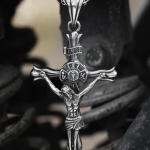When it comes to wearing rings, each finger can carry its own unique meaning and symbolism. Among these, the middle finger stands out as a focal point of intrigue and interest. What does it signify when a man chooses to adorn his middle finger with a ring? To uncover the depth of meaning behind this choice, let’s delve into a journey through the diverse interpretations and cultural contexts that have shaped this unique practice.
Different Cultural Meanings of Wearing a Ring on the Middle Finger
Wearing a ring on the middle finger carries diverse cultural meanings that span continents and epochs. Let’s explore some of the interesting explanations associated with this practice:
1. Ancient Rome: Signet Rings and Authority
In ancient Rome, signet rings were often worn on the middle finger. These rings featured engraved symbols or initials and were used to create seals in wax on important documents. The middle finger’s central position made it convenient for pressing the seal, signifying authority and authenticity.
Julius Caesar, one of history’s most famous figures, was known to wear a signet ring on his middle finger. This ring was not only a symbol of his power but also a practical tool for sealing important documents with his mark.
2. Islamic and Ottoman Traditions: Connection to Faith
In Islamic and Ottoman cultures, men often wore rings on the middle finger, particularly on the right hand. These rings may bear inscriptions from the Quran or other religious texts, and they hold both religious and decorative significance. They were considered a connection between the wearer and their faith.

In the Ottoman Empire, sultans and high-ranking officials would wear ornate rings on their middle fingers, often featuring intricate calligraphy and precious gemstones. These rings were not only symbols of their authority but also expressions of their Islamic faith.
3. Western Cultures: Balance and Responsibility
In the cultural context of Western societies, specifically in the United States and Europe, the middle finger serves as a potent symbol of equilibrium and the unwavering commitment to fulfill responsibilities. Positioned at the heart of the hand’s digits, it embodies the notion of balance, reminding individuals to harmonize the demands of work, family, and personal life. Wearing a ring on this finger becomes a visual testament to the importance of maintaining equilibrium and upholding duties with diligence and integrity.
Difference between Wearing a Ring on the Left and Right Middle Finger
Wearing a ring on the left and right middle fingers can convey different meanings depending on cultural, religious, and personal contexts. Here’s a summary of the main differences:
Left Middle Finger:
- Engagement and Marriage: In many Western cultures, the left middle finger is traditionally associated with engagement and marriage. An engagement ring is typically worn on this finger to symbolize a commitment to marriage. This tradition is especially common in countries like the United States and Canada. It’s often followed by a wedding ring during the marriage ceremony.

- Religious or Cultural Rings: Some religions or cultures may have specific rings that are traditionally worn on the left middle finger. For example, in some Christian traditions, a bishop may wear a special cross ring on the third finger of his left hand as a symbol of his office.
Right Middle Finger:
- Promise or Purity Ring: In some cultures and communities, individuals may choose to wear a promise or purity ring on the right middle finger to symbolize a commitment to abstain from certain behaviors until marriage.
- Cultural Significance: In some cultures, wearing a ring on the right middle finger may hold specific cultural or familial significance. Rings worn on this finger may be passed down through generations and hold special meaning for the wearer.
- Same-Sex Relationships: In same-sex relationships, couples may choose to wear rings on the same or different fingers based on their own preferences and what holds meaning for them as a couple. This can vary widely depending on individual and cultural practices.
Different Types of Rings on the Middle Finger for a Man
Here are various types of rings that a man might choose to wear on the middle finger, each with its own style, symbolism, and cultural significance. Here are some examples:
1. Signet Ring
Signet rings have a flat, engraved surface typically featuring a family crest, monogram, or other meaningful symbol. Historically, signet rings were used to create seals in wax, signifying authority or authenticity. Today, they are often worn for their classic and distinguished appearance.
1936 HOBO NICKELS LIBERTY STAINLESS STEEL SKULL RING
2. Cocktail Ring
Cocktail rings are bold, statement pieces with large, eye-catching gemstones. They are worn for their striking appearance and can signify confidence and a flair for fashion.
3. Claddagh Ring
The Claddagh ring is a traditional Irish ring featuring a heart, crown, and hands. It represents love (heart), loyalty (crown), and friendship (hands), making it a popular choice for relationships and friendships.
IRISH CLADDAGH STAINLESS STEEL CELTIC KNOTS RING
4. Masonic Ring
Masonic rings have symbols and emblems associated with Freemasonry. They signify membership in the Masonic fraternity and may hold personal significance for members.
5. Religious Ring
Religious rings often feature symbols or imagery from a specific faith, such as crosses, Stars of David, or Islamic calligraphy. They serve as expressions of faith and devotion to a particular religion.
Address 5 Common Misconceptions Regarding Men Wearing Rings on the Middle Finger
Certainly, there are a few common misconceptions about men wearing rings on the middle finger that are worth addressing:
1. It’s Only a Sign of Rebellion or Nonconformity
While some may associate wearing a ring on the middle finger with rebellion or nonconformity, this is a broad generalization. The choice of finger can hold various cultural, personal, or symbolic meanings. It’s important to recognize that interpretations vary widely, and the middle finger can be chosen for a multitude of reasons beyond a desire to rebel.
2. It Has Negative Symbolism
Some may mistakenly associate rings on the middle finger with negative symbolism, like defiance or offensive gestures. While certain cultures or contexts may have specific meanings for finger gestures, the wearing of rings itself does not universally imply negativity.
3. It’s Only for Women
Rings are unisex accessories, and there are no strict gender restrictions on which finger to wear them. Traditionally, certain fingers might be associated with specific meanings or occasions, but these conventions are evolving. The middle finger, like any other, is a valid choice for anyone who wants to wear a ring.
4. It Signifies a Particular Sexual Orientation or Lifestyle
Wearing a ring on the middle finger, or any finger for that matter, does not inherently signal one’s sexual orientation or lifestyle. It’s important not to make assumptions about someone’s identity based on their choice of jewelry.
5. It’s Inappropriate for Professional Settings
Whether wearing a ring on the middle finger is appropriate in a professional setting depends on the workplace’s dress code and culture. In many modern workplaces, personal style and expression are more accepted, but it’s still important to be mindful of professional.
Conclusion
In conclusion, the significance of a ring on the middle finger for a man encompasses a tapestry of cultural, personal, and historical threads. From its roots in ancient civilizations to its modern interpretations, this choice of adornment serves as a powerful form of self-expression. Above all, it’s essential to recognize that the meaning behind this choice is deeply individual. It transcends gender norms and societal expectations. So, for those considering donning a ring on their middle finger, embrace it with confidence, and let it tell your story.
Daisy
Daisy Wang is a talented and passionate writer known for her captivating storytelling and love for literature. With a diverse background and a bachelor's degree in English Literature, Daisy brings a unique perspective to her work. Her areas of expertise span various subjects, including history, fashion, and lifestyle. Through her words, Daisy aims to inspire curiosity, foster meaningful connections, and leave a lasting impact on readers.
Recent Posts
Your Goth Christmas Style Guide
11/25/2025Cybergoth Aesthetic
11/11/2025Categories
Related Articles
Acubi Fashion: The Ultimate Guide to the Minimalist Edgy Look
In the fast-moving world of digital trends, fashion cycles seem to refresh...
ByAlicia12/25/2025Your Goth Christmas Style Guide
The holiday season is often painted in bright reds, greens, and sparkling...
ByAlicia11/25/2025Moss & Misdemeanor: Fairy Grunge Style and Outfits
The fashion world constantly mixes ideas to create new, unique looks. The...
ByAlicia11/18/2025Cybergoth Aesthetic
The alternative landscape is constantly evolving, but few aesthetics hit as hard...
ByAlicia11/11/2025














Leave a comment